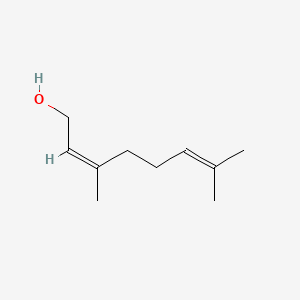| Authors | Title | Published | Journal | PubMed Link |
|---|---|---|---|---|
| Nishio E et al. | 3-Hydroxy-3-methylglutaryl coenzyme A reductase inhibitor impairs cell p4fferentiation in cultured adipogenic cells (3T3-L1). | 1996 | Eur. J. Pharmacol. | pmid:8773465 |
| Phillips WR et al. | C-geranyl compounds from Mimulus clevelandii. | 1996 | J. Nat. Prod. | pmid:8778239 |
| York M et al. | Evaluation of a human patch test for the identification and classification of skin irritation potential. | 1996 | Contact Derm. | pmid:8833466 |
| Chinou IB et al. | Chemical and biological studies on two Helichrysum species of Greek origin. | 1996 | Planta Med. | pmid:8792676 |
| Nishikitani M et al. | Geranyl 6-O-alpha-L-arabinopyranosyl-beta-D-glucopyranoside isolated as an aroma precursor from leaves of a green tea cultivar. | 1996 | Biosci. Biotechnol. Biochem. | pmid:8704326 |
| Fukuda T et al. | Two new monoterpene glycosides from ku-ding-cha. Inhibitors of acyl-CoA: cholesterol acyltransferase (ACAT). | 1996 | Chem. Pharm. Bull. | pmid:8945784 |
| Miquel K et al. | Farnesol and geranylgeraniol induce actin cytoskeleton disorganization and apoptosis in A549 lung adenocarcinoma cells. | 1996 | Biochem. Biophys. Res. Commun. | pmid:8780704 |
| Koyama T et al. | Identification of significant residues in the substrate binding site of Bacillus stearothermophilus farnesyl diphosphate synthase. | 1996 | Biochemistry | pmid:8755734 |
| Rastogi SC et al. | Natural ingredients based cosmetics. Content of selected fragrance sensitizers. | 1996 | Contact Derm. | pmid:8879930 |
| Dorries KM et al. | Olfactory sensitivity to the pheromone, androstenone, is sexually dimorphic in the pig. | 1995 | Physiol. Behav. | pmid:7716200 |
| Kenerva L et al. | Occupational allergic contact dermatitis caused by ylang-ylang oil. | 1995 | Contact Derm. | pmid:8565465 |
| Cain WS et al. | Comparison of models of odor interaction. | 1995 | Chem. Senses | pmid:8788096 |
| Yu SG et al. | Geraniol, an inhibitor of mevalonate biosynthesis, suppresses the growth of hepatomas and melanomas transplanted to rats and mice. | 1995 | J. Nutr. | pmid:7472655 |
| Kisselev O et al. | Efficient interaction with a receptor requires a specific type of prenyl group on the G protein gamma subunit. | 1995 | J. Biol. Chem. | pmid:7592699 |
| Frosch PJ et al. | Patch testing with fragrances: results of a multicenter study of the European Environmental and Contact Dermatitis Research Group with 48 frequently used constituents of perfumes. | 1995 | Contact Derm. | pmid:8565489 |
| Shibuya H et al. | Chemical transformation of terpenoids. X. Ionophoretic activities of macrocyclic lactone epoxides synthesized from geraniol. | 1994 | Chem. Pharm. Bull. | pmid:8149455 |
| Morales B et al. | Inhibitory K+ current activated by odorants in toad olfactory neurons. | 1994 | Proc. Biol. Sci. | pmid:7991632 |
| Chiruvolu S et al. | A phase of liposomes with entangled tubular vesicles. | 1994 | Science | pmid:7973704 |
| Hallahan DL et al. | Cytochrome P-450-catalysed monoterpenoid oxidation in catmint (Nepeta racemosa) and avocado (Persea americana); evidence for related enzymes with different activities. | 1994 | Biochim. Biophys. Acta | pmid:7918588 |
| Moreno PR et al. | Induction of ajmalicine formation and related enzyme activities in Catharanthus roseus cells: effect of inoculum density. | 1993 | Appl. Microbiol. Biotechnol. | pmid:7763550 |
Nerol
Nerol is a lipid of Prenol Lipids (PR) class. The involved functions are known as Odorant, Anabolism, Diastasis, Metabolic Inhibition and Oxidation. Nerol often locates in germ tube. The related lipids are Octanols, Pinene, Hexanols, ethyl butyrate and ethyl hexanoate.
Cross Reference
Introduction
To understand associated biological information of Nerol, we collected biological information of abnormalities, associated pathways, cellular/molecular locations, biological functions, related genes/proteins, lipids and common seen animal/experimental models with organized paragraphs from literatures.
What diseases are associated with Nerol?
There are no associated biomedical information in the current reference collection.
No disease MeSH terms mapped to the current reference collection.
PubChem Associated disorders and diseases
What pathways are associated with Nerol
There are no associated biomedical information in the current reference collection.
PubChem Biomolecular Interactions and Pathways
Link to PubChem Biomolecular Interactions and PathwaysWhat cellular locations are associated with Nerol?
Visualization in cellular structure
Associated locations are in red color. Not associated locations are in black.
Related references are published most in these journals:
| Location | Cross reference | Weighted score | Related literatures |
|---|
What functions are associated with Nerol?
Related references are published most in these journals:
| Function | Cross reference | Weighted score | Related literatures |
|---|
What lipids are associated with Nerol?
Related references are published most in these journals:
| Lipid concept | Cross reference | Weighted score | Related literatures |
|---|
What genes are associated with Nerol?
There are no associated biomedical information in the current reference collection.
What common seen animal models are associated with Nerol?
There are no associated biomedical information in the current reference collection.
